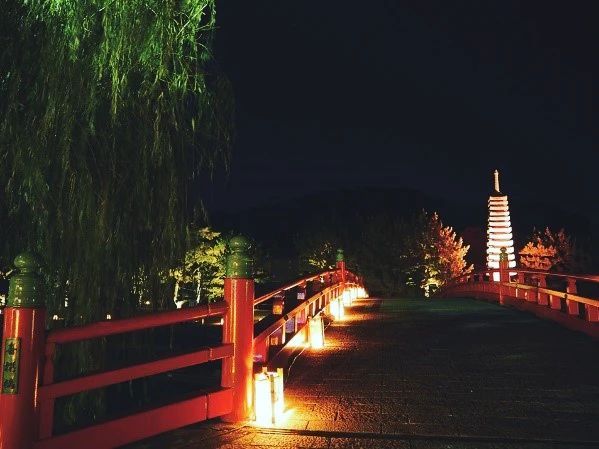The Kyo no Tanabata Festival in Kyoto commemorates the celestial love story of Orihime and Hikoboshi, who are said to be separated by the Milky Way and allowed to meet only once a year. Originating from China and integrated into the Kikkoten Festival, this event attracts visitors from all over the world.

Notable features include captivating illuminations along the Kamogawa River and Horikawa River, as well as art installations showcasing innovative illumination techniques. Performances and exhibitions encompass a range of cultural expressions, such as yukata fashion shows, maiko dances, and musical and dance performances.

The festival also incorporates a tradition of writing wishes on paper strips and tying them onto bamboo branches, which are then offered to the heavens in a bonfire.
The Kyo no Tanabata Festival is a highly anticipated event in Kyoto during the month of August.
Key Takeaways
- Kyo no Tanabata Festival celebrates the love story of celestial lovers Orihime and Hikoboshi, who can only meet once a year due to being separated by the Milky Way.
- The festival features mesmerizing illuminations along the Kamogawa River and Horikawa River, creating a fantastical atmosphere with circular bamboo spheres filled with light and enchanting wind chime installations.
- Art students contribute to the festival by donating illuminated bamboo displays, and unique illumination techniques can be found at different festival sites.
- The festival offers various performances and exhibitions, including artisans washing yuzen silks, a yukata fashion show, Maiko dances, and musical and dance performances on multiple stages.
Legend and Origins

The Kyo no Tanabata Festival in Kyoto celebrates the legend of celestial lovers Orihime and Hikoboshi, who are separated by the Milky Way and can only meet once a year. The legend of Orihime and Hikoboshi originated from China and was incorporated into the Kikkoten Festival in Japan.
During the festival, people pray to Orihime’s star for proficiency in skills like needlework and calligraphy. The festival is renowned for its mesmerizing illuminations along the Kamogawa River and Horikawa River. Circular bamboo spheres filled with light create a fantastical atmosphere, while furinto, enchanting wind chime installations, add to the magical ambiance.
Decorative bamboo branches adorned with wishes are a sight to behold, and an illuminated bamboo arch tunnel represents the Milky Way. Art students contribute to the festival by donating illuminated bamboo displays, which are positioned throughout the festival area.
The festival also features various performances and exhibitions, showcasing traditional Japanese culture and attracting a large number of visitors.
Illuminations and Decorations

Circular bamboo spheres filled with light create a fantastical atmosphere at the Kyo no Tanabata Festival. These captivating illuminations can be found along the Kamogawa River and Horikawa River, enchanting visitors with their magical ambiance.
The bamboo spheres, carefully crafted and illuminated, emit a soft glow that adds to the overall enchantment of the festival. Plus, the festival features furinto, mesmerizing wind chime installations, which further enhance the ethereal atmosphere.
The decorations also include decorative bamboo branches adorned with wishes, a sight that is both visually stunning and symbolically significant. On top of that, an illuminated bamboo arch tunnel represents the Milky Way, connecting the celestial lovers Orihime and Hikoboshi.
These illuminations and decorations contribute to the overall enchanting experience of the Kyo no Tanabata Festival, creating a sense of freedom and wonder for all who attend.
Art Installations

Positioned throughout the festival area, illuminated bamboo displays created by art students contribute to the artistic ambiance of the Kyo no Tanabata Festival. These art installations enhance the magical atmosphere and captivate the audience with their creativity and beauty.
Here are five remarkable features of these displays:
- Whimsical shapes and forms that evoke a sense of wonder and enchantment.
- Vibrant colors that create a visually stunning and lively environment.
- Intricate designs that showcase the skill and craftsmanship of the art students.
- Playful use of light and shadow that adds depth and dimension to the installations.
- Interactive elements that allow festival-goers to engage with the art and become part of the creative experience.
These art installations not only contribute to the aesthetic appeal of the festival but also create a sense of freedom and joy, inviting visitors to immerse themselves in the magical world of Kyo no Tanabata.
Performances and Exhibitions
Performances and exhibitions at the Kyo no Tanabata Festival showcase various forms of traditional arts, cultural displays, and entertainment, providing a diverse and enriching experience for attendees.
The festival offers a range of performances, including the Yuzen Nagashi of Light, where visitors can witness artisans washing yuzen silks, and a yukata fashion show and silkworm craft workshop at the Nishijin Textile Center. Plus, maiko gracefully dance in tea houses, showcasing Kyoto’s geisha culture. Multiple stages across festival locations feature various musical and dance performances, adding to the vibrant atmosphere.
On top of that, food stalls offer local specialties such as peaches and wasabi, allowing attendees to indulge in the region’s culinary delights. These performances and exhibitions contribute to the overall immersive experience of the festival, creating a sense of cultural celebration and entertainment for all who attend.
Wishing Traditions

Wishing traditions at the annual summer event in Kyoto involve attendees writing wishes on tanzaku strips of paper and tying them onto bamboo branches, creating a visual representation of collective hopes and aspirations. This traditional practice allows participants to express their desires and dreams in a tangible way, fostering a sense of unity and shared purpose. The bamboo branches, adorned with colorful tanzaku strips fluttering in the wind, create a captivating sight that adds to the enchanting atmosphere of the festival. Plus, the Kyo no Tanabata Festival provides installations specifically designed for hanging wishes, offering participants a convenient and meaningful way to contribute to the collective wishes of the event. This inclusive practice not only engages the local community but also extends a warm welcome to international visitors, promoting a sense of connection and cultural exchange.
| Wishing Traditions | International Support |
|---|---|
| Attendees write wishes on tanzaku strips of paper | English website, pamphlet, and information stall |
| Wishes are tied onto bamboo branches | Efforts cater to international guests |
| Visual representation of collective hopes and aspirations | English support ensures foreigners can fully enjoy festival |
Additional Information
With approximately 650,000 visitors each year, the festival has become a beloved summer tradition that attracts both locals and travelers alike. Its unique offerings, such as the Arashiyama Toro Nagashi event, further contribute to its popularity.
Taking place in August along the Oi River, this spectacle involves the floating of lanterns, creating a serene and beautiful scene against the backdrop of the scenic Arashiyama area. This event, much like the Kyo no Tanabata Festival, showcases the rich cultural heritage of Kyoto and provides an opportunity for visitors to immerse themselves in the magical ambiance of the city.
Whether attending the festival or witnessing the lanterns at Arashiyama, these experiences offer a glimpse into the captivating traditions and vibrant spirit of Kyoto.
Frequently Asked Questions
What are some other festivals in Kyoto that take place in August?
Some other festivals in Kyoto that take place in August include the Arashiyama Toro Nagashi event, where lanterns are floated along the Oi River, and the Kikkoten Festival, which incorporates the legend of Orihime and Hikoboshi.
How long has the Kyo no Tanabata Festival been celebrated in Kyoto?
The Kyo no Tanabata Festival has been celebrated in Kyoto for several years. The exact duration of the festival is not mentioned in the given information.
Are there any specific rituals or ceremonies associated with the festival?
The Kyo no Tanabata Festival in Kyoto features several rituals and ceremonies. Attendees can write wishes on tanzaku strips of paper and tie them onto bamboo branches. At the end of the festival, collected wishes are sent heavenward in a bonfire at Kiyomizu Temple.
Can visitors participate in any hands-on activities during the festival?
Visitors can participate in various hands-on activities during the Kyo no Tanabata Festival. These include witnessing artisans washing yuzen silks, attending a yukata fashion show and silkworm craft workshop, and writing wishes on tanzaku strips of paper.
Are there any restrictions or guidelines for writing wishes on tanzaku strips of paper?
There are no specific restrictions or guidelines for writing wishes on tanzaku strips of paper during the Kyo no Tanabata Festival. Visitors are free to express their wishes and tie them onto bamboo branches as they see fit.
The Sum Up
The Kyo no Tanabata Festival in Kyoto celebrates the enchanting love story of Orihime and Hikoboshi, celestial lovers separated by the Milky Way. Originating from China and incorporated into the Kikkoten Festival, this event is renowned for its mesmerizing illuminations along the Kamogawa and Horikawa Rivers.
Art installations created by talented students showcase unique illumination techniques, while performances and exhibitions offer a glimpse into traditional Japanese culture. Wishing traditions allow attendees to send their wishes heavenward in a bonfire.
The Kyo no Tanabata Festival is a highly anticipated event that attracts visitors from all over the world.




